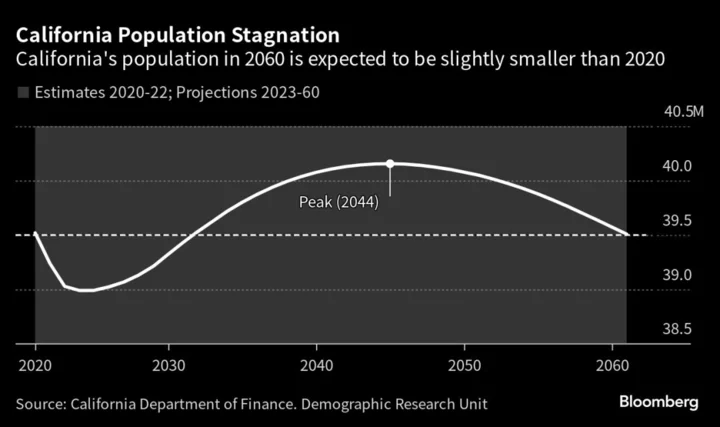More than a century of long-term population growth in California could be over, according to new projections that show the state will have about the same number of people in 2060 as it does now.
The forecast released this week from the California Department of Finance is sobering news for the country’s most populous state, which saw its first-ever population decline in 2020 amid an exodus driven by the pandemic and high housing costs. Lower birth rates and aging baby boomers will add to the demographic drag over the coming decades.
The department predicts that there’ll be 39.5 million people in the state by 2060. Just three years ago, forecasters were expecting the number to be 45 million — and a decade ago, the population was seen surging to almost 53 million.
Population losses over the last few years will have a compounding effect in the future, says Andres Gallardo, a demographer who works for the state government. “You don’t have those people, and those people don’t have kids,” he says, adding that it’s the first time California’s long-term forecast has shown the population staying flat.
There are already real consequences for the state. California lost a House seat in 2021 — the first since achieving statehood in 1850 — and the new population estimates could signal more to come. By comparison, Texas — the second most populous state — is projected to expand from 30 million people to 36.7 million by 2060, according to its latest forecast from 2022.
What’s more, California’s tax base will be eroded, and many population-related jobs such as school teachers will come under pressure since there’ll be fewer students.
‘Voting With Feet’
If there’s a bright spot in the forecast, the state is at least expected to recoup its pandemic population decline in the coming years — returning to its 2020 population level in the 2030s, before peaking in 2044.
Eric McGhee, a senior fellow at the Public Policy Institute of California, says the long-term forecast is “more illustrative than it is predictive,” because it’s hard to project that far ahead. But he says it poses real questions for California’s leaders as they grapple with a housing affordability crisis.
“California’s government really wants to be helping people who are worse off and giving them opportunities and we see they are leaving the state,” said McGhee. “People are voting with their feet.”
The impact could be biggest in regions like the County of Los Angeles, which is expected to shrink by 1.7 million people from 2020 to 2060.
The forecasts are based on a combination of natural increase in population — births minus deaths — and net migration. The demographers project that the number of deaths in California will exceed births by 2035.
The total fertility rate for California has been below what’s known as the replacement level, of 2.1 births per woman, since 2009 and it’s projected to decline to 1.5.
Meanwhile, the number of deaths is expected to jump to more than 460,000 a year in the 2050s — up by about 150,000 from this year’s estimate, as the baby-boomer demographic ages. The number of Californians aged 95 or more is expected to jump fourfold by 2060 to almost half a million.

